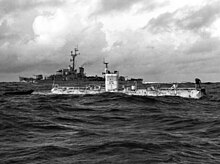

Project Nekton was the codename for a series of very shallow test dives (three of them in Apra Harbor) and also deep-submergence operations in the Pacific Ocean near Guam that ended with the United States Navy-owned research bathyscaphe Trieste entering the Challenger Deep, the deepest surveyed point in the world's oceans.
The series of eight dives began with two harbor dives, then a Pacific Ocean test dive at Guam, by the newly modified Trieste, which had been modified to dive far deeper than before. After two checkout dives, the first abyssal dive reached a record of 5,530 m (18,150 ft) on 15 November 1959. The series included a record deep dive to near the bottom of the Nero Deep in the Mariana Trench at 7,300 m (24,000 ft), and finally culminated with a trip to the bottom of the Challenger Deep at 10,911 m (35,797 ft), on 23 January 1960.[1][2]
The project name was proposed by oceanographer Dr. Robert S. Dietz in early 1958, as plans to modify the Trieste bathyscaphe to go to the deepest part of the oceans were being contemplated. It is in reference to ocean life that actively swims (nekton) as opposed to the plankton organisms that only drift. The bathyscaphe Trieste to be used for Project Nekton was able to move independently, in contrast to tethered bathyspheres. The Trieste featured two electric motors, each with a propeller, of 1.5 kilowatts (2 hp) each. These allowed it to move forward, backward and to turn horizontally. A maximum speed of one knot (0.5 m/s) was attainable over a few miles distance.[3]
- ^ "To the Depths in Trieste". College of Marine Studies. University of Delaware. Archived from the original on 27 March 2010. Retrieved 1 March 2010.
- ^ Piccard, Jacques and Dietz, Robert S. (1961). Seven Miles Down; The Story of the Bathyscaph Trieste. G. T. Putnam's Sons. 60-16679.
{{cite book}}: CS1 maint: multiple names: authors list (link)See page 133 for name origin, page 231 for propeller and motor description
© MMXXIII Rich X Search. We shall prevail. All rights reserved. Rich X Search
